Maine Lobster Roll Recipe
This post may contain affiliate links, which means that I may receive a commission if you make a purchase using these links. As an Amazon Associate I earn from qualifying purchases.
A Maine lobster roll lets the flavor of the lobster shine. Chilled lobster meat is lightly dressed with mayo, salt, and pepper, and piled into a toasted New England-style hot dog bun.
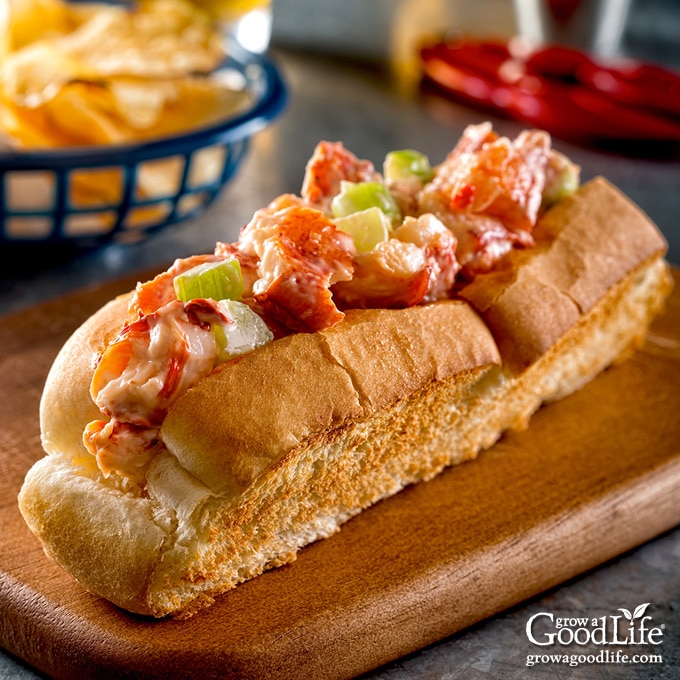
Folks take their summer seafood seriously here on the coast of New England. The classic clambake is a common theme for family reunions and gatherings with friends. The meal is filled food and lively conversation, all while cracking lobsters, clams, squirting juice everywhere, dipping in melted butter, and eating with your hands.
The best time to make lobster rolls is the day after a clambake. We always cook extra lobsters just for the leftovers. They are refrigerated overnight, and the meat is removed from the shells the following day and turned into lobster salad for lobster rolls.
Ingredients for Lobster Rolls
A simple, chunky lobster roll is made from fresh caught, cooked, and chilled lobster meat, combined with a little mayo, seasoned, and heaped into a warm butter-toasted, New England-style bun.
Lobster is the star of the sandwich. You don’t want other ingredients to overpower the wonderful lobster flavor. Here are the simple ingredients for making a classic Maine lobster roll:
- Lobster Meat: Fresh lobster meat is the way to go. I have included instructions for boiling your own lobster, but many lobster pounds will do the cooking for you. Just call ahead and ask. You want fresh lobster meat cooked within a day or so.
- Mayonnaise: You are aiming for a very light covering of mayo on the lobster meat. Add it a little at a time and toss gently until the meat is coated.
- Celery: If you like a little crunch in your lobster roll, add a bit of diced celery to the lobster salad mix. You can also add a lettuce leaf to the bun before filling. I like it plain with a sprinkling of chives for a little color.
- Salt: Salt enhances the lobster flavor, but taste the lobster after mixing with the mayo before adding salt. You may not even need to add salt if the lobster absorbed some flavoring while cooking.
- Pepper: Freshly ground pepper adds a warm, slightly bitter note.
- New England Hot Dog Buns: A Maine lobster roll is not complete without a buttered and toasty New England-style roll. You can make it extra special by baking your own New England hot dog rolls with this recipe.
- Lemon Juice: A light squeeze of lemon juice helps balance the richness of the lobster and mayo.
How to Boil Lobsters
If you don’t have leftover lobster meat from another meal, you can cook and chill your lobster ahead of time. We are going to boil the lobsters for this lobster roll recipe. Boiling cooks the lobsters quickly triggering the meat to contract, which makes it easy to remove it from the shells.
If you prefer to steam your lobsters, follow the instruction found in this clambake recipe.
Many lobster pounds, seafood markets, and even grocery stores will cook lobsters. If you are uncomfortable boiling live lobsters yourself, give them a call and see whether they will cook them for you.
Buying Live Lobsters
You will find fresh caught lobsters available along the coast of Maine at local fish markets and lobster pounds. Most grocery stores also carry lobsters during the summer months. You can also have live lobsters shipped to you overnight.
The type of lobsters available may be soft-shelled or hard-shelled depending on the season. Lobsters molt and shed their outer shells as they grow. Underneath the old shell is a new one, but it will be soft and flexible right after molting, and hardens up over time. Shedding usually occurs from July to September. Soft-shelled lobsters contain less meat than hard-shell, but the meat is sweet, and they are much easier to crack and clean using just your hands.
Inspect the tank and choose lobsters that are healthy and moving around. When lifted from the water, they should arch their claws and tail when picked up. Choose lobsters around the same size, so they will cook evenly.
Live lobsters should be cooked the day you purchase them. Get them home right away and keep them cool and damp until you are ready to cook them. Place them in an open container such as a plastic storage bin and keep them in the fridge.
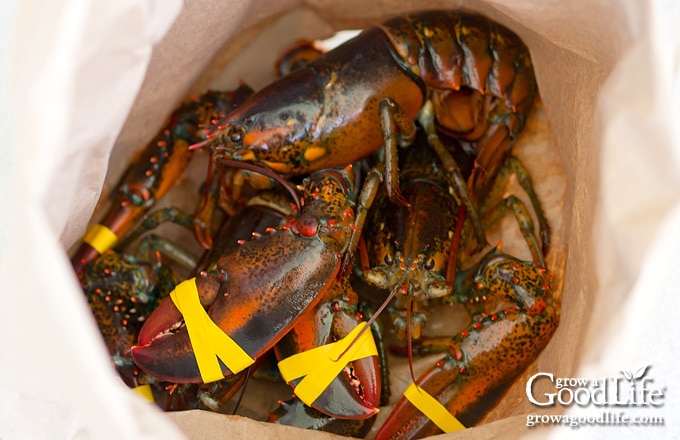
Use a Large Pot
You will need a pot large enough to hold the lobsters and keep them submerged under the water by a few inches. An 18 to 20-quart pot is plenty big for cooking four lobsters at once and allow the heat to circulate. Cook in batches if your pot is smaller.
How Long to Boil Lobsters?
This recipe is for lobsters that weigh about 1 1/4 pound. Adjust the cooking time to the size of your lobsters. Let the pot come to a boil and then cook for:
- 1 pound: 5 to 6 minutes
- 1 1/4 pound: 7 to 8 minutes
- 1 1/2 pound: 8 to 9 minutes
- 2 pound: 10 to 12 minutes
- 3 pound: 12 to 14 minutes
Lobsters are fully cooked when the meat looks opaque and the internal temperature is 140˚F. To check, stick an instant read thermometer into the joint where the tail meets the body. If you don’t have a thermometer, cut the shell where the tail meets the body. If the meat is white, the lobster is fully cooked. If it is still translucent, return it to the pot and cook a little longer.
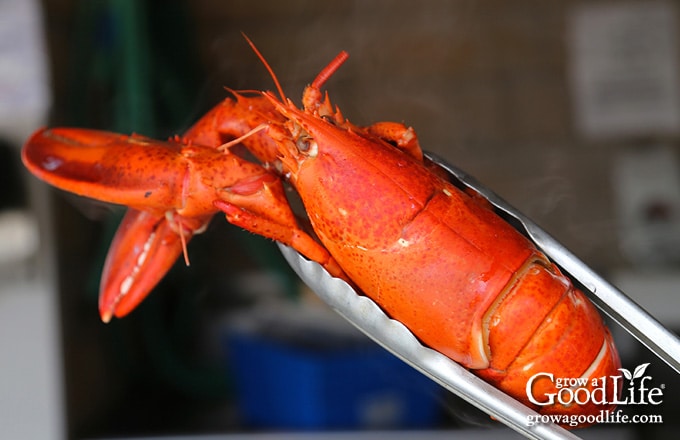
How to Clean a Lobster
Once the lobsters are finished cooking, remove them from the pot using tongs. Snip the tips of the claws and let the extra water drain into the pot. Set the lobster aside to cool slightly. Once the lobsters are cool enough to handle, get cracking:
- Claws: Twist a claw to separate it from the body. Crack the claw with a lobster cracker and remove the meat. Crack the knuckle joints, and fish out the meat with a fork or picker. Repeat with the second claw.
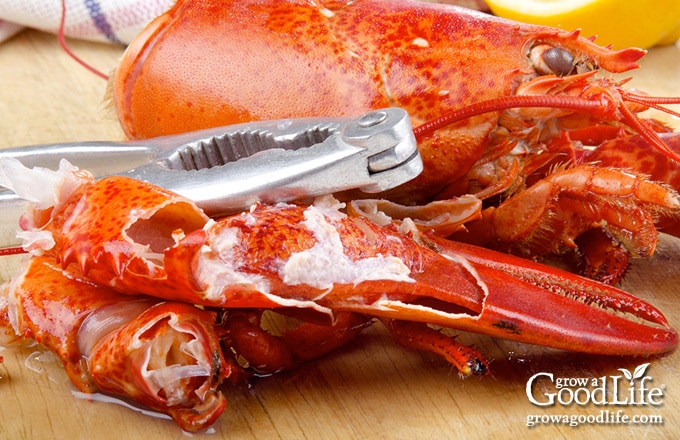
- Tail: Separate the tail from the body by arching it back until it cracks. Break off the tail flippers and pull out the meat from each piece. Push a fork through the small end and push the tail meat out of the opposite end. Peel back the top layer and remove the black vein that runs along the tail.
- Body: Pull off the shell apart by lifting it up and away from the legs. Remove and discard the green tomalley (liver). Crack the body and pull out the meat. The meat in the legs is tough to remove with tools, but don’t let it go to waste. Break the legs apart and suck out the meat.
It is interesting to note that most of the printed “How to Eat Lobster” instructions that restaurants still use today on placemats, bibs, and plates come from an original illustration published back in the 1950s by Maine Department of Sea and Shore Fisheries. (Source: Cuisinology.com)

How to Make a Lobster Roll
The actual process of making a lobster roll is a simple one. Break the lobster meat into chunks and chill it in the refrigerator. Combine it with just enough mayonnaise to give it a light coating, add some salt and pepper to taste, and pile into a toasted New England-style hot dog bun.
Serve lobster rolls with a side of coleslaw, chips, fries, or onion rings, and a dill pickle to balance the richness of the lobster.
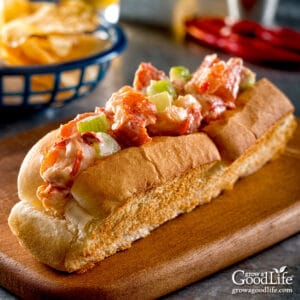
Maine Lobster Roll
Ingredients
- 4 live lobsters about 1 1/4-pounds each
- 4 gallons water
- 2 tablespoons sea salt optional for flavor
- 1 stalk celery diced (optional)
- 1/2 cup mayonnaise
- kosher salt to taste
- fresh ground pepper to taste
- 4 New England style hot dog buns sliced in the middle
- 2 tablespoons unsalted butter softened
- 1 lemon cut into 4 wedges
Instructions
Boil the Lobsters:
- Fill a large pot about 3/4 of the way with water. Add two tablespoons of sea salt for extra flavor if desired. Bring to a boil over high heat.
- Snip off the elastics from the claws and then plunge the lobsters into the boiling water headfirst. Cover and bring the pot back to a boil.
- Once the water is boiling, cook the lobsters 7 to 8 minutes, depending on the size of the lobster (see note below for other sizes).
- Remove the lobsters from the pot using tongs. Lobsters are fully cooked when the internal temperature is 140˚F, and the meat is firm and opaque.
- Check the temperature with an instant read thermometer in the joint where the tail meets the body. Or cut the shell where the tail meets the body. If the meat is white, the lobster is fully cooked. If it is still translucent, return it to the pot and cook a little longer.
- Once the lobsters are cooked, snip the tips of the claws and hold up to let the extra water drain out. Set aside to cool.
- When the lobsters are cool enough to handle, crack the shells and extract the meat. Break the meat into desired sizes and refrigerate until cold.
Make the Lobster Roll:
- Drain the chilled lobster meat to remove any extra moisture.
- In a large bowl, toss the chilled lobster meat with the celery (if using) and mayonnaise until the meat is lightly coated. Start with half the mayo, and add more as needed until it is at the consistency you like.
- Add salt and pepper to taste, and set aside while you toast your roll.
- If you are not ready to make the lobster roll right away, pop the lobster salad back in the refrigerator. Remove and let it sit at room temperature for a few minutes to take the chill off while you prepare your rolls.
- To toast the buns, warm a skillet over medium heat. While the pan is heating, spread a thin layer of the softened butter along both sides of the rolls.
- Place the bun butter side down into the hot skillet, and toast until browned, about 2 minutes each side.
- Fill the warm buns with lobster salad and serve with lemon slices, chips, or your favorite sides. Makes about 4 generous sized lobster rolls.
Notes
• 1 pound: 5 to 6 minutes
• 1 1/4 pound: 7 to 8 minutes
• 1 1/2 pound: 8 to 9 minutes
• 2 pound: 10 to 12 minutes
• 3 pound: 12 to 14 minutes
Nutrition
Hungry for More?
- Slow Cooker New England Baked Beans
- Tourtière French Canadian Meat Pie
- Classic New England Pumpkin Pie
Good planning is key to a successful vegetable garden
Whether you are new to growing your own food or have been growing a vegetable garden for years, you will benefit from some planning each year. You will find everything you need to organize and plan your vegetable garden in my PDF eBook, Grow a Good Life Guide to Planning Your Vegetable Garden.

